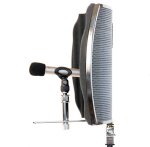SAMTheGreat
New member
what are some ways to ? seems like the frequency i find the verb in , is also the frequency that brightens up the vocal , any tips ?
after setting up acoustics that isokay thanks , maybe a reflection filter ?
Until you get your studio fully acoustically treated (or if you're in a situation where you can't make permanent alterations) the sE Reflexion filter does and amazingly good job. A very OCD acoustic consultant friend of mind says that the pro version is probably about 80% as good as a fully treated room if you follow the set up instructions carefully.
whoa sounds dope , thanksOk so for future reference, never record with reverb. Those reflection filters are a good idea, but quick diy hanging panels should do the job until you have the money to invest in treatment. Try SPL transient designer on the vocals to remove the reverb. There's a knob for attack and one for sustain, bring the sustain down to get ride of that reverb tail. I've been pretty successful with it.
 ...well, not that cheap, and it's a multi-layer filter (not just foam and metal mesh), but mine is not a wrap-around, and that's why I chose it. It's a smaller type with just a slight curve, that I use mostly to "reflect" stuff coming at the back of the mic (like AC wind noise) and not really as a "treatment"....and I can position it for a lot for other things besides just vocals. You can get a mic in close to guitar cabs and whatnot, and still have the filter behind the mic.
...well, not that cheap, and it's a multi-layer filter (not just foam and metal mesh), but mine is not a wrap-around, and that's why I chose it. It's a smaller type with just a slight curve, that I use mostly to "reflect" stuff coming at the back of the mic (like AC wind noise) and not really as a "treatment"....and I can position it for a lot for other things besides just vocals. You can get a mic in close to guitar cabs and whatnot, and still have the filter behind the mic.The way they use the sE filter, you really have to tuck that mic deep inside of it, and it does wrap around the mic quite a bit, so it probably takes out most of those early reflections and dries up the vocal....but that doesn't really make it a broad-band trap, and as already mentioned, you need one reflection filter per mic...and those filters are not very usable for anything else but vocals because of the way they wrap around the mic, and make positioning for other stuff difficult.
<snip>
Sorry, but this is completely against the instructions that come with the filter (at least the original sE version). They instruct you to put the mic so the capsule is exactly in line with the two front edges of the filter.
Well....that may be the case with the instruction in the original version. I never looked at them when sE first came out with a reflection filter, but in the current "Pro" model they make no reference to a specific mic position, and instead tell you that the mic bar allows both vertical and horizontal placement of the mic, so you have to tailor the placement based on your room.
http://www.seelectronics.com/static/downloads/cms/manuals/rf-manual-updated.pdf
.


